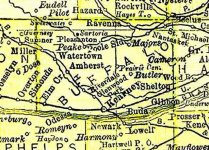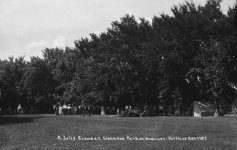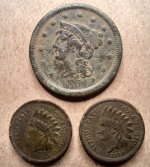Gypsy Heart
Gold Member
A jolly crowd at Glenwood Park on the Wood River, north of Kearney, Nebraska.
Nebraska--Buffalo County--Kearney (vicinity)--Wood River
The Blue Mills on the Wood River north of Kearney was a flourishing mill for nearly fifty years. A story in the Kearney Daily Hub of November 10, 1970, was written by Patricia Richter Reinhardt, who lived as a child on the farm where the mill was located.
Sylvester Bearss and his descendants operated the mill continually through various difficulties until a few months before the dramatic fire which destroyed it in October of 1920. Not only did it serve the community by milling grain but it provided an amusement park in the area above the dam. Family members say the name Blue Mills came from an outcropping of blue clay he found in the river bed. County records show he bought the land in 1883 and filed for flowage rights for a darn 12 feet high in 1884.
The first mill building, described by Mr. Bearss' grandson, Chelcy Bearss, was a small frame structure with a gate-type water wheel. The mill stones were about two and one-half feet in diameter and set in a steel frame. The first dams were of sod with brush on both sides and were frequently washed out by floods.
The mill burned about 1892, and was rebuilt with more modern machinery, and a steam engine was added to assist water power. To avoid flood destruction, a concrete dam was built. However, before too many years, a loud explosion, the cause of which was never known, destroyed the dam. The next dam was concrete built on top of the first one.
In 1908 the business was taken over by Guy Bearss, a son. Guy's wife Cordelia is said to have baked a batch of bread from each milling to test the quality of the flour. Three grades of flour were made. The mill had a 50-barrel capacity in 24 hours. Farmers hauled their wheat to the mill and traded it for flour and other products, such as cracked wheat for breakfast food, pancake flour, or poultry feed. During World War I rye, buckwheat, barley and corn flour were sometimes substituted for wheat flour.
In 1920 the mill was sold to Warren Ewell. A fifty percent drop in retail flour prices later that year caused Mr. Ewell to go into debt and to lose business. Eight months after the mill was sold, a Halloween night fire completely destroyed the Blue Mills. Ewell was later arrested for arson, tried and found guilty. The mill was never rebuilt.
Glenwood Park, created at the widened river above the dam, was the scene in the late 1880s of family picnics, swimming, boating, fishing, even a baseball field on the flat area above the river bed. The park was owned and operated by Charles Nelson and closed around 1910 after his death.....
http://freepages.history.rootsweb.ancestry.com/~howardlake/amusement13/glenwoodne.html
Nebraska--Buffalo County--Kearney (vicinity)--Wood River
The Blue Mills on the Wood River north of Kearney was a flourishing mill for nearly fifty years. A story in the Kearney Daily Hub of November 10, 1970, was written by Patricia Richter Reinhardt, who lived as a child on the farm where the mill was located.
Sylvester Bearss and his descendants operated the mill continually through various difficulties until a few months before the dramatic fire which destroyed it in October of 1920. Not only did it serve the community by milling grain but it provided an amusement park in the area above the dam. Family members say the name Blue Mills came from an outcropping of blue clay he found in the river bed. County records show he bought the land in 1883 and filed for flowage rights for a darn 12 feet high in 1884.
The first mill building, described by Mr. Bearss' grandson, Chelcy Bearss, was a small frame structure with a gate-type water wheel. The mill stones were about two and one-half feet in diameter and set in a steel frame. The first dams were of sod with brush on both sides and were frequently washed out by floods.
The mill burned about 1892, and was rebuilt with more modern machinery, and a steam engine was added to assist water power. To avoid flood destruction, a concrete dam was built. However, before too many years, a loud explosion, the cause of which was never known, destroyed the dam. The next dam was concrete built on top of the first one.
In 1908 the business was taken over by Guy Bearss, a son. Guy's wife Cordelia is said to have baked a batch of bread from each milling to test the quality of the flour. Three grades of flour were made. The mill had a 50-barrel capacity in 24 hours. Farmers hauled their wheat to the mill and traded it for flour and other products, such as cracked wheat for breakfast food, pancake flour, or poultry feed. During World War I rye, buckwheat, barley and corn flour were sometimes substituted for wheat flour.
In 1920 the mill was sold to Warren Ewell. A fifty percent drop in retail flour prices later that year caused Mr. Ewell to go into debt and to lose business. Eight months after the mill was sold, a Halloween night fire completely destroyed the Blue Mills. Ewell was later arrested for arson, tried and found guilty. The mill was never rebuilt.
Glenwood Park, created at the widened river above the dam, was the scene in the late 1880s of family picnics, swimming, boating, fishing, even a baseball field on the flat area above the river bed. The park was owned and operated by Charles Nelson and closed around 1910 after his death.....
http://freepages.history.rootsweb.ancestry.com/~howardlake/amusement13/glenwoodne.html







